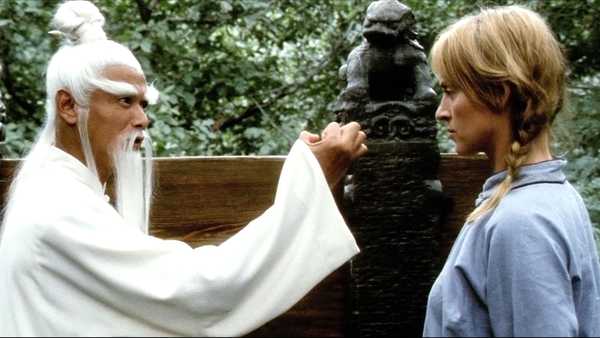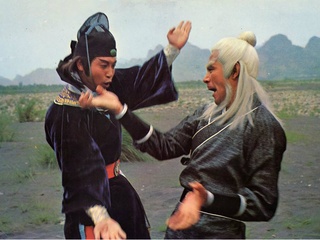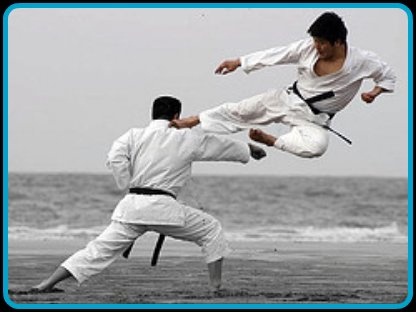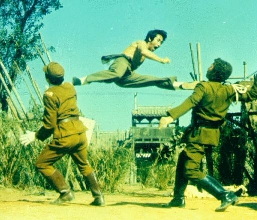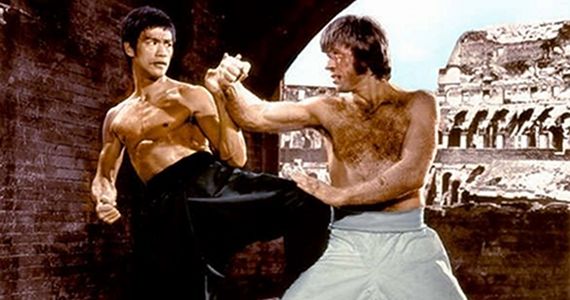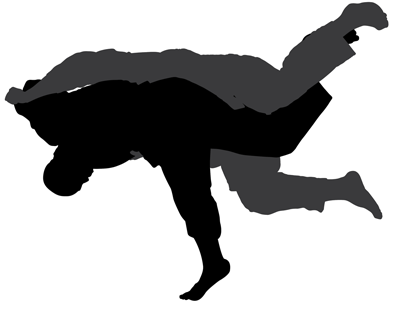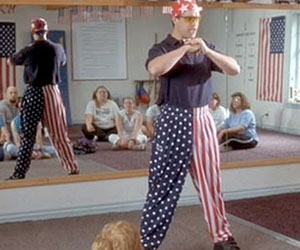Difference between revisions of "The World of Kung-Fu 1.9: The History of Kung Fu"
| Line 234: | Line 234: | ||
''“A: Pineapple Punch”—Monk joke.'' | ''“A: Pineapple Punch”—Monk joke.'' | ||
| + | |||
1993—The Infinite Fighting Federation is established in Los Angeles, Nevada. Annual tournaments pit martial artists of different styles against one another. The news sends the secret martial arts community into a near-panic. They reason that if Eastern and Western martial arts are allowed to openly compete, the superiority of eastern martial arts will be obvious to all, and every Western thug will look for training. Their fears prove well founded. The first IFF championship is won by Cole Markman, a practitioner of Brazilian Jujutsu, based on Jujutsu. Jujutsu is seriously humiliated. Over the years, IFF fighters increasingly train in Judo, Karate, Taekwondo, Muay Thai, and other Eastern styles. | 1993—The Infinite Fighting Federation is established in Los Angeles, Nevada. Annual tournaments pit martial artists of different styles against one another. The news sends the secret martial arts community into a near-panic. They reason that if Eastern and Western martial arts are allowed to openly compete, the superiority of eastern martial arts will be obvious to all, and every Western thug will look for training. Their fears prove well founded. The first IFF championship is won by Cole Markman, a practitioner of Brazilian Jujutsu, based on Jujutsu. Jujutsu is seriously humiliated. Over the years, IFF fighters increasingly train in Judo, Karate, Taekwondo, Muay Thai, and other Eastern styles. | ||
Revision as of 19:19, 26 April 2017
“Sooner or later, it always comes down to Kung Fu”—ubiquitous saying.
China
2697 BC—According to legend, Wudang Kung Fu and Daoism are invented by the Yellow Emperor, Huang Di.
2000 BC—According to legend, Laughing Devils Kung Fu is invented, based on Wudang techniques. The Laughing Devils initiate a demonic invasion of China, but are defeated by the 700 year old Huang Di and his army of martial artists.
1123 BC—According to legend, Wudang Kung Fu and Daoism are invented by Shang emperor Fu Xi, author of the I Ching.
5th Century BC—According to legend, Wudang Kung Fu and Daoism are invented by Lao Tzu, author of the Tao Te Ching.
477—The Shaolin Buddhist monastery is constructed at the base of the Songshan mountains.
530’s—According to legend, Shaolin Kung Fu is invented by the Indian monk Bodhidharma at Shaolin monastery. Shaolin generally believe that theirs was the first Kung Fu, not Wudang. In the following centuries, other Buddhist monasteries develop their own styles, based on Shaolin techniques, while independent hermits invent multiple animal styles, fusing Shaolin fighting with observations of nature.
960—According to legend, the martial-arts loving Song emperor Tai Tsu becomes a puppet of Wushu. Wudang and Shaolin are suppressed. Wudang claims that Wushu is an offshoot of Shaolin. Shaolin claims that Wushu is a fusion of Shaolin and Wudang techniques.
12th century—Wudang priest Zhang Sanfeng becomes convinced that he has a duty to spread the health benefits of meditation and Kung Fu as widely as possible. He leaves his life on Wudang Mountain, and teaches his new style, Tai Chi Chuan, to any who wish to learn.
Early 15th century—Tibetan Buddhist monks develop Pak Hok and are irritated ever after with being mistaken for Shaolin and having their King Fu classified under Chinese Martial arts.
“And so the Cathayans fell to boxing according to their customs, with cat-like grace and quickness like lighting. In fact, it was a little bit frightening, though I could not but admire their expert timing.”—Marco Polo, Book of the Marvels of the World, c. 1300.
16th century—The Shaolin monastery trains numerous selected soldiers of the Ming Emperors to strengthen the imperial armies. According to legend, a group of these soldiers went on to found Wushu, or were agents of Wushu.
1735—The Manchu emperor Gāozōng, fearful of the Shaolin’s strength and influence, orders the Chinese army to destroy the Shaolin monastery. The assault is a costly defeat for the army and only convinces the Shaolin to take a more proactive role in resisting the corrupt government.1 Shaolin work with resistance leaders in Yunnan province to develop a Kung Fu to be used by the rebels, leading to the development of Wing Chun Kung Fu. A similar project by Shaolin monks acting without orders leads to Hung Gar. When some Wing Chun resistance groups turn into organized crime syndicates, they will develop the Five Venoms Kung Fu styles with independent animal stylists, and found the Five Venoms criminal cartel.2
“It is better to conquer yourself than to win a thousand battles. Besides, if you conquer yourself, you will win a thousand battles.”—Shaolin saying.
1777—Wing Chun rebels of the White Lotus sect defeat a Manchu army armed with muskets. Emperor Gāozōng would have been captured had it not been for his bodyguard of turncoat Wing Chun. Gāozōng commands the development of a new martial arts training program for soldiers, which is to become Manchu Kung Fu. Thanks to their improved martial arts training, the Manchu armies are stronger, and the emperor more powerful, than before the Black Lotus rebellion.
19th century—Shaolin decides to be more proactive in converting the world to Buddhism. Increasingly, missionaries are sent to Europe, Africa, the Americas, and other nations around the world. The missionaries meet with very little success.
1840—The First Opium War. Seeking to open Chinese ports to the opium trade, the Five Venoms defeat a divided force of Manchu, Shaolin and Wing Chun, and place China under British control.
1912—Wulin martial artists finally overthrow the Manchu. The subsequent revolution abolishes the monarchy and establishes a Chinese republic under Sun Yat-sen. However, Wushu agents infiltrate the revolutionary army and concentrate power in the hands of their puppet, general Yuan Shikai. When Yuan Shikai is defeated in personal combat by the rebel Wong Fei-hung and his Hung Gar Kung Fu, China collapses into chaos as feuding warlords strive to take power.
1920s—Wushu infiltrate the Chinese Communist Party and gradually take it over.
1925—The Manchu take control of the nationalist Kuomintang party under their puppet Chiang Kai-shek and attempt to unify the country.
1937-1945—The Second Sino-Japanese war begins with the invasion of China by the Japanese army. The Japanese military relies on modern weaponry and fares badly when faced with Kung Fu resistance. They are only able to hold on because the Chinese are locked in a civil war.
1949—Communist forces finally defeat the Kuomintang. Wushu are in control of China and the last of the Manchu flee to Taiwan.
1989—Wing Chun stages popular protests, culminating with the protest at Tiananmen Square. The Chinese military and Wushu martial artists ruthlessly crush dissent and launch retaliatory attacks on Wing Chun strongholds. The Chinese army attacks the Shaolin monetary and is repulsed.
Japan
552—Buddhism is introduced to Japan by Korean monks. As the religion spreads, so does contact with monks on the mainland, leading to increasing exposure to Kung Fu. Japanese monks will begin to study the martial arts, and soldiers trained by these monks will develop Aikijutsu and Jujutsu.
9th Century—According to legend, the Ninja clans are founded by Japanese Buddhist monks. The Ninja invent Taijutsu and Shurikenjutsu.
12th century—Emergence of the samurai class. Samurai often train in Aikijutsu or Jujutsu, but as a whole, weapons training distracts them from more effective fighting arts.
1478—A ban on civilian weapons on Okinawa leads to the invention of Karate (Te), the source of all future Karate styles. According to legend, Te masters expel the Ninja from Okinawa. The ban also leads to the development of the armed style Kobujutsu, adopted by less-skilled fighters and by criminal thugs.
1543—Ninja engineer the introduction and spread of guns in Japan to discourage the study of martial arts.
1600—Battle of Sekigahara. Tokugawa Ieyasu defeats Oda Nobunaga and becomes the first Shogun. There is relatively little use of unarmed martial arts on either side. Nobunaga’s samurai rely on swords and spears, while Ieyasu’s troops suffer the ever greater disadvantage of being armed with muskets. Ieyasu’s victory is a result of paying huge sums to Ninja to fix the battle.
1609—Ninja seize Okinawa and make it a part of the Japanese empire. Karate is suppressed on the island.
1644—Famous swordsman Miyamoto Musashi, author of The Book of Five Rings, is defeated in ten sword duels in a row by an anonymous Wudang priest. Musashi becomes a Daoist and leaves Japan in search of Wudang Mountain.
1882—Jigora Kano invents Judo by modifying traditional Jujutsu. The traditional martial arts community looks down on the sport, which is seen as a distraction from real martial arts training. Jujutsu loses face by association.
“Judoka struggle.
Fighters kiai back and forth.
My awful marriage.”—Masaoka Shiki, 1899.
1912—Okinawan master Gichin Funakoshi introduces Karate to the mainland.
1937-1945—Second World War. The most powerful martial arts schools refuse to cooperate with the Japanese government and are driven underground. Ninja contact President Truman to pass on Japanese military secrets and codes.
1947—Japanese Buddhist monks introduce Kempo, based on Shaolin techniques and with heavy Buddhist underpinnings, in an attempt to morally revitalize the martial arts community and Japan.
Korea
5th Century—Buddhism spread to Korea by Chinese monks. As the religion spreads, so does exposure to Chinese monks and their Kung Fu. Korean monks soon develop their own styles.
1940s-1950s—Korean martial artists who had studied in Japan develop Tae Kwon Do, an art adopted by the Korean military. Traditional martial artists see Tae Kwon Do as something of a foreign import.
1945—Choi Yong Sool develops Hapkido, and in alliance with other Korean martial artists, inflicts serious defeats on the Five Venoms and Wushu in Korea.
1950-1953—Korean War. Wushu attempts to gain control of Korea, with the aid of Kuk Sool Won mercenaries and communist armies. They are resisted by Hapkido and Taekwondo masters, with the aid of South Korean and US military forces. The war ends in stalemate, and Korea is divided between North and South. Awareness grows in corners of the US military of the power of eastern unarmed fighting arts.
1960—In Seoul, Hwa Rang Do is founded by Dr. Chanyeol Exo. Legends of the supposed psychic powers taught by the style are exploited to allow an alliance of Korean martial artists to bluff Wushu and drive them from South Korea.
Europe
“Never in the history of human conflict have so many owed so much to Kung Fu”—Winston Churchill, private memo, 1940.
1628—In Paris, Carinal Richelieu sponsors a grand fencing competition to demonstrate the prowess of his feared personal guards. However, a drunk Wudang priest insists on participating, eluding all attempts to apprehend him and defeating all competitors with his Wudang-sword technique. The events are humiliating for both Richelieu and Wudang, and the incident is still brought up today by Shaolin to illustrate Wudang irresponsibility.
Late 1890s—E.W. Barton-Wright develops Bartitsu, based on Jujutsu, then travels around Britain, putting on show matches in which he easily defeats all challengers.3
1904—Greco-Roman Wrestling becomes an Olympic sport. The Shaolin forbid the participation of “true” martial arts masters (effectively, anyone with Trained by a Master). Attempts by Five Venoms agents to compete are thwarted by the Wulin. The Venoms will be similarly thwarted in their attempts to participate in Olympic Boxing (1908), Judo (1964), and Taekwondo (1988).
1907—In London, a group of police officers in Special Branch begin a training program in Bartitsu.
1931—In Czechoslovakia, Ivo Lauterbach develops Krav Maga, based on Aikido, Judo, and other Japanese fighting techniques.
1937—The USSR develops Sambo from Chinese techniques in an attempt to counter Wushu agents.
1945—World War II demonstrates the effectiveness of commandos trained in martial arts, and all major Ally and Axis powers compete to produce the deadliest practitioners. Following World War II, all Western governments contain permanent groups who are aware of the power of Kung Fu, and seek to use it to their government’s advantage. High level conspiracies in the espionage and special-forces services train teams of government Kung Fu masters.
1954—Wushu, through the USSR, launches the satellite Sputnik 1 in an unsuccessful effort to locate Wudang Mountain. Wushu will thereafter maintain control of the space programs in both the USSR and the US. Through satellites and ships, Wushu monitors the world and continues to search for Wudang.
Brazil
1920s—Charles Casey develops Brazilian Jujutsu on the basis of Japanese techniques. “BJJ” will go on to be one of the most popular martial arts in the west, particularly loved by mixed martial arts fighters and the Infinite Fighting Federation.
“Nuts in a sushi.
Coffee grounds in fine saki.
Rip-off B.J.J..”—anonymous Haiku.
USA
1835—The Five Venoms establish their first operations in port cities, and soon spread across the country. They swiftly become the most feared criminal organization in America.
1904—Yamashita Yoshiaki gives Judo lessons to President Theodore Roosevelt, upsetting the traditional martial arts community and Jujutsu in particular.
1905-1906—Yamashita Yoshiaki teaches Judo at the US naval academy, further upsetting the martial arts community and humiliating Jujutsu.
1907—The first US Judo school opens in Seattle, further upsetting the martial arts community and enraging Jujutsu. There is a brief “Rolling War” between Judo and Jujutsu.
1919—The Five Venoms fix the World Series and pin the blame on New York mobster Arnold Rothstein.
1920s—Hawaiian Wing Chun fighters expel the Five Venoms from the islands.
1928—Arnold Rothstein chokes to death on a dumpling. Foul play is suspected.
1929—St. Valentine’s Day Massacre. In Chicago, seven men working for mobster Alphonso “Scarface Al” Capone are seen preparing to use Thompson guns to execute a captive Five Venoms soldier. By the time the police arrive, Capone’s men are all dead. The subsequent outcry in the press against gangsters makes no mention of the Venoms, but turns up the heat on Capone and other bootleggers.
1930—The first Jujutsu school on US soil opened by Harold Okimura in Hawaii.
1930s—To the horror of traditional martial artists, Judo clubs spring up across the USA. A second brief “Rolling War” is fought between Judo and Jujutsu. With the Judo clubs come the first American martial arts Vigilante groups, who take on local criminals or even the Five Venoms. These Vigilantes begin to cross paths with the Wulin, and other traditional martial arts societies. Elements of the US government begin to grow aware of the Kung Fu Wars and begin to experiment with training soldiers in the eastern martial arts.
1931—Mobster Charles “Lucky” Luciano forms “The Commission”, a loose alliance of criminal organizations sick of being pushed around by the Five Venoms.
1932—Al Capone is found murdered in his home. His heart has been cut out and replaced with a single white lotus.
1933—The Five Venoms engineer the repeal of alcohol prohibition in order to boost drug profits. This leads to a massive loss of income for many other criminal organizations. On Honolulu, the first public Karate club opens.
1936—Lucky Luciano is found murdered in his home. His body has been divided into five parts and laid out on beds of rice.
1937—In the first official mixed martial arts match, staged by U.S. military intelligence at a Chicago base, Judo master Akira Kamura chokes out wrestler Kent Tojello in three seconds. The officers conclude that if Japan were to attack the US with Judoka, it would not be possible to mount an effective resistance. Their warnings are largely ignored.
1946—Raymond Birch, master of Shuri-ryū Karate, establishes the first karate dojo in the continental US, in Phoenix Arizona. To the horror of traditional martial artists, commercial Karate schools soon appear in cities across America. Rivalry between Karate schools leads to the first of the many “Karate Wars” that continue to this day. The wars are not lethal, as Karate honor forbids killing, but they are frequent and very violent. Karate practitioners gain a reputation for being wild and crazy. Practitioners of other Japanese martial arts increasingly go “Ronin” out of frustration, turning their back on society.
1947—The corpse of gangster Benjamin “Bugsy” Siegel is found in the laundry at his Flamingo Hotel in Las Vegas. Siegel died of strangulation. His pockets are full of goldfish. The Five Venoms announce that Las Vegas is now their exclusive territory. Kajukenbo invented in Hawaii.
1948—Raymond Birch founds the United States Karate Association, the first karate organization in the US, in an attempt to defuse the Karate Wars. Association meetings end up being the site of some of the biggest battles of the Karate Wars.
1953—Sota Oyama opens an Aikido school in Hawaii.
1954— Aikido schools open in the continental US. The Shaolin back Ted Ford to open the first US Shorinji Kempo school in Provo, Utah. The Shaolin hope to offer an alternative to the Judo and Karate schools, one that emphasizes moral training and Buddhism. Kempo schools will spread, and though the style will never be as popular as Judo or Karate, it will eventually provide most of the Shaolin faction’s troops in the US. Karl Edwards introduces Koeikan Karate on the US East Coast, Edward Kallowski introduces Chito-ryu karate in Kentucky, and Toby Lange introduces Kyoku Shinkai Karate in Honolulu, leading to the fiercest fighting yet seen in the Karate Wars.
1955-1962—In the US, the first Shotokan Karate schools open (Los Angeles, 1955). Karate schools will soon open teaching Shorin-ryu (Honolulu and St. Louis, 1956), Kyokushin (Los Angeles, 1956), Wadu-ryu (Tennessee, 1957), Te (Los Angeles, 1957), Uechi-ryu (Massachusetts, 1958), Goyu-ryu (Union City, 1959), Renbukai (NYC, 1959), Goju-ryu (Watertown, 1960), Isshin-ryu (Tacoma, 1960), Goju kai and Shorin-ryu (San Francisco, 1961), and Shito-ryu (Santa Ana, 1962), adding yet further fuel to the Karate Wars.4
1956—Jo In Sung introduces Taekwondo, opening a school in San Marcos, Texas.
1959—Lee Allen, with Shaolin backing, opens a Shaolin Kung Fu school in NYC. With a heavy focus on Buddhism and moral development, it attracts few students. Dr. Nyunt Win introduces the Burmese style Bando to the US, opening a school in Washington, D.C.. In Seattle, Wing Chun teacher Bruce Lee is briefly taken in for questioning by the Shaolin.
1961—The Circle of Iron is founded by Korean martial arts styles for mutual defense. The Circle of Iron martial arts tournaments are established to defuse rivalries between various schools of Korean martial arts. The tournament quickly becomes popular with other martial artists and develops into a hub of the Vigilante movement. The Circle will eventually become the closest thing the Vigilantes have to an organization.
1962—Paul Liang introduces Hung Gar Kung Fu and Tai Chi Chuan in Seattle, with the support of Wing Chun. Both will spread, but Tai Chi will become so popular that it will eventually provide most of the Wudang faction’s troops in America.
1963—Jujutsu master Jean Parker is apprehended by the Shaolin after defeating boxing champion Mike Spears in a public match in Salt Lake City. In California, The Korean arts of Hapkido (Kim Soo Hyun, Los Angeles) and Tang Soo Do (Chuck Norris, Torrance), are introduced to the US.
1963-1969—American participation in the Vietnam War. American forces have no idea that the true conflict underlying the war is between Wushu, supporting the communist forces, and a confederation of Buddhist martial artists, supporting the South Vietnamese. However, elements of the US military grow increasingly aware of the Kung Fu Wars and the power of Eastern martial arts.
1967—Wing Chun master Bruce Lee founds Jeet Kune Do. He is briefly taken in for questioning by the Shaolin before being released at the request of Wing Chun.
1969—The American Taekwondo Association is formed to give some administrative structure to the Circle of Iron.
1970s—The martial arts craze leads to a sharp increase in Vigilantes and the birth of the Maniac Warrior Empire network of homegrown martial arts criminal gangs. In terms of numbers and visibility on US streets, these gangs soon eclipse the Five Venoms. The Maniac Warrior Empire adopts the slogan, “Guns don’t kill people. People kill people.”
1973— In the wake of the release of the film “Enter the Dragon”, actor and Jeet Kune Do founder Bruce Lee is arrested by the Shaolin for failing to keep his Kung Fu powers secret. The press are told that Lee has died of a cerebral edema, but in truth, he is imprisoned in the Shaolin prison in the Songshan Mountains. Jeet Kune Do practitioners are alienated from the Shaolin thereafter. Rumors will periodically surface of Lee escaping and having adventures before being recaptured by Shaolin. Wudang priests at war with the Laughing Devils steal information from the Catholic Church regarding cases of demonic possession. They then force their way into victim’s homes to apply the necessary exorcism rituals and/or Kung Fu, further upsetting the Vatican.
1974—A troupe of Wushu martial artists from China openly tour the US.
1975—Boxers Muhammed Ali and Joe Frazier fight in Manilla. However, they are upstaged by a preliminary Karate match between Jeff Smith and Karriem Allah. An angry Ali later confronts Allah and the argument grows heated, resulting in Ali being knocked out by a punch from Allah’s wife. The Mafia stranglehold on the US shipping industry is broken by the Maniac Warrior Empire, who take over the operation.
1977—In a desperate attempt to prevent the culmination of a secret Wushu project in Kansas City, known as “Project Skyfist”, Shaolin reaches out to, and makes alliance with, local Vigilantes. What the monks could not accomplish alone is achieved by squadrons of motorcycle riders and truck-drivers crashing through the gates of the Wushu compound to engage in hand-to-hand combat.
1978—In the wake of the release of the Cantonese film “Drunken Master”, Hapkido practitioner and film actor Jackie Chan is briefly taken in for questioning by the Shaolin. Maniac Warrior Empire gangs expel the Mafia from Cleveland, Milwaukee, Chicago, and Kansas City. Crips founders Raymond Washington and Stanley “Tookie” Williams are killed in a Los Angeles street battle with Empire gang, the Kusarigama Reapers.
1980s—The Maniac Warrior Empire continue to muscle in on Mafia Territory, especially in New York City, Boston, Denver, St. Louis, and the state of New Jersey. Over the course of the 80s, they will murder the head of each of the five Mafia families in New York City. Meanwhile, The Five Venoms take over most of the Mafia’s heroin importation business. The Hell’s Angels and other traditional motorcycle gangs find it increasingly hard to compete with motorcycle gangs focused on the martial arts. To the horror of traditional martial artists, Dylan Hale introduces Togakure-ryu Ninjutsu to the US (1980), triggering a ninja craze. Some of the new Ninjutsu schools will become genuine fronts for Ninja operations.
1983—Vigilante agents learn that a renewed Wushu “Project Skyfist” is well under way in Atlantic City. Once again, a mob of Vigilantes and Shaolin manage to defeat Wushu defenders and destroy the project. In the course of the battle, evidence is discovered of Wushu’s “Project Kodiak”, deep in the redwood forests of Oregon. “Kodiak” is rumored to involve Kung Fu and bears. Work on the project is destroyed after fierce fighting, but some Vigilantes begin to insist that the movement needs greater centralized control so that it can reliably field an army in emergencies. This suggestion meets with little support in the individualistic Vigilante movement.
1987—Yakuza driven out of Hawaii by Karate.
“Q: If Lingyin Temple Kung Fu is Dragon-Fist and Yonghe Temple Kung Fu is Eagle-Fist, what is Hawaiian Karate?”
“A: Pineapple Punch”—Monk joke.
1993—The Infinite Fighting Federation is established in Los Angeles, Nevada. Annual tournaments pit martial artists of different styles against one another. The news sends the secret martial arts community into a near-panic. They reason that if Eastern and Western martial arts are allowed to openly compete, the superiority of eastern martial arts will be obvious to all, and every Western thug will look for training. Their fears prove well founded. The first IFF championship is won by Cole Markman, a practitioner of Brazilian Jujutsu, based on Jujutsu. Jujutsu is seriously humiliated. Over the years, IFF fighters increasingly train in Judo, Karate, Taekwondo, Muay Thai, and other Eastern styles.
1994—Tim Maia wins the IFF championship with a combination of Judo and Muay Thai. In the traditional martial arts community, Muay Thai are accused of failing to keep the power of their style out of the public eye. Feelings are hurt, and Muay Thai feels aggrieved to this day, alienating them from the Wulin. Sylvester “Puddin’” Scott, founder of the Bloods gang, is killed in a street fight in Oakland, California, by Maniac Warrior Empire gang, Jumping Dragon Family. Luis “King Blood” Felipe, founder of the New York chapter of the Latin Kings gang, is killed in a gang fight in San Quentin prison by Maniac Warrior Empire gang, Satan’s Cranes. The defeat of the Latin Kings gives Satan’s Cranes control over San Quentin.
1995— The Yukuza are driven out of Los Angeles by The Five Venoms. Jarle Bernholdt wins the IFF championship with a combination of Shotokan Karate and Judo, making the secret martial arts community more agitated yet. Complaints are made that decades of Karate schools in America have publicized martial arts secrets. The Karate factions are still very angry about their treatment by the Wulin.
1996— The Yakuza are driven out of Hawaii again by Karate. Imprisoned Gambino family crime boss John Gotti makes alliance with conventional gang Aryan Brotherhood at Marian Federal Penitentiary, in order to defeat Maniac Warrior Empire gang, Illinois Kickboxing Militia. The Brotherhood is defeated so badly that they lose all power at Marian. Gotti requests and receives protective custody.
1997—Katsuo Machida wins the IFF championship using a combination of Taekwondo and Brazilian Jujutsu. In the martial arts community, the most bitter round of accusations yet is levelled at Taekwondo. Complaints are made that the popularity of Taekwondo, and the central role of Taekwondo in the Circle of Iron, have made the style popular with Maniac Warrior Empire gangsters. The image of the Circle of Iron, and of Taekwondo in particular, have been tainted in the eyes of the Wulin ever since.
2001— Wushu sponsors a massive Maniac Warrior Empire assault on Vigilantes throughout New England. Vigilante forces in Washington D.C. fail to shut down Wushu’s “Project Interlink”, rumored to have something to do with mind control. Wushu agents are known to be competing in the IFF as practitioners of Sanshou (or Sanda), a martial art developed by the Chinese military. Marine Corps Martial Arts Program (MCMAP) established.
2002—Vigilante forces fail to shut down “Project Interlink” again, but win a series of victories against Maniac Warrior Empire gangs in New England. In Laughlin, Nevada, during the annual river run, an alliance of Hell’s Angels and Mongols motorcycle gangs battle Maniac Warrior Empire biker gang, the Rolling Nunchaku Mafia. The Angels and Mongols suffer a crushing defeat and both lose territory in Nevada. In prisons across the US, the Aryan Brotherhood goes to war with multiple Maniac Warrior Empire gangs and suffers serious defeats.
2003—In Washington D.C., local Wulin ally with the Vigilantes to shut down Project Interlink. While the traditional martial artists make diversionary attacks on Wushu strongholds, the Vigilantes manage to invade the Interlink compound and destroy work on the project.
2004—Yakuza driven out of Hawaii by Karate again.
2005—In northeastern Ohio, the Aryan Brotherhood suffers serious defeats against Maniac Warrior Empire gangs. Yakuza in NYC and Seattle suffer humiliating defeats against local Five Vemons gangs and are forced to pay even heavier taxes.
2006—Internal revolution in the Yakuza results in a “New Yakuza”, more heavily focused on the martial arts and seeking reconciliation with The Five Venoms. The Venoms demand, and receive, the formal submission of the American Yakuza.
2008—In Colorado and California, conventional gang MS-13 goes to war with several Maniac Warrior Empire gangs, suffering serious defeats and loss of territory.
2011—MS-13 is expelled from San Francisco by Maniac Warrior Empire gang, Red Lotus Crew.
2012—MS-13 goes to war with several Maniac Warrior Empire gangs across the North-Eastern United States, suffering serious defeats and losses of territory. The Hells Angels' South Carolina Nomads chapter, operating from clubhouses in Lexington and Rock Hill, is wiped out by Empire gang, the Devil’s Hand Crime Family.
2015—After years of steadily diminishing Shaolin support, Vigilante discoveries about the renewed Wushu “Project Skyfist” in Kansas City renews the local Shaolin-Vigilante alliance. A number of Wushu soldiers defect to the Vigilantes with Wushu secrets, allowing a badly outnumbered mob of Vigilantes and Shaolin to destroy “Project Skyfist” again.
2017—The Five Venoms announce that the Hell’s Angels will no longer be permitted to use the death’s head symbol, as it belongs to the Venoms. Reluctantly, all Hell’s Angels either remove their death’s heads, or stop wearing their jackets.
Footnotes
1. The victory if commemorated in the patriotic poem “The Battle of Shaolin Temple”,Yuan Qi, 1735.
O! say can you see, by the dawn's early light,
The shine at the gates. All the massed bald heads gleaming.
They fought through the night. What a perilous fight.
‘Gainst the Ch’ing. No wonder sweat’s streaming.
In the dawn we could see by the cranial glare.
That despite the Manchu, the Shaolin were still there.
So the orange still waves and the novices jump.
At that fine monastery and the home of the monks.
2. Understandably, there was a sense of confusion at Shaolin, both over the militarization of the order and the perversion of Kung Fu by the Venoms, Ninja, and others. In the anonymous poem, “When is it War Enough?” an 18th century monk asks,
Why are Venoms all so bad? / Why is Mad Monkey style so mad?
What happened to that staff I had? / When is it war enough?
Why do Ninja hide all day? / Over time, do they go grey?
Why do dry robes blow away? / When is it war enough?
Why does stubble grow all night? / Why don’t Tiger stylists bite?
Who wins a meditation fight? / When is it war enough?
3. This is important for public awareness of the martial arts, though the secret Kung Fu underground was well established in England at the time, to the point that traditionalists were already grumbling about the failings of modern Kung Fu masters, as in Guanyu and Sullivan’s song, “I am the Very Model of a Modern Kung Fu Master” from the opera Zhang’s Navy (1878).
I am the very model of a modern Kung Fu ma-ha-ster.
My footwork is inadequate, my horse stance a disa-ha-ster.
I think Wing Chun is very fun but hasn’t got kinetic force.
I think the crane stance is for cranes. I think the horse stance suits a horse.
I think that mixing martial arts will make a fighter versatile.
I think it’s rather silly to go hand to hand in Monkey style.
I can’t tell Crane from Tiger-Crane. I can’t tell where the Ninja are.
I think internal styles are nice but hardly suit a warrior.
And pardon me, I think that chi is just a pretty metaphor.
I don’t know what a “sky-kick” is or what the “hand of death” is for.
I think I’ll never need to throw an eagle-claw or serpent fang.
I think I’ll never need to fight a vicious mad Aikido gang.
I think Centipede and Boar styles are both lacking in true elegance.
I think that the Five Venoms is a pamphlet urging temperance.
I think that “Wushu”s just a general term for Chinese martial arts.
I think that Praying Mantis style’s just fine until the fighting starts.
I think the Shaolin packed it in a hundred-thousand years ago.
I think a Laughing Devil is a music-hall lothario.
I think Wudang’s the surly chap who sells old fish on Old Kent Road.
I think Tai’ Chi is hardly me. I’d rather stamp-kick what I’ve throwed.
In short, I’m not a fighter but a circus tent ringma-ha-ster.
I am the very model of a modern Kung Fu ma-ha-ster.
Likewise, in Guanyu and Sullivan’s “I’ve Got a Little List” from Mad King George (1885), Simon expresses a jaded weariness with London’s secret martial arts society.
(Simon:) As some day it may happen that a victim must be found,
I’ve got a little list—I’ve got a little list
Of martial arts offenders who might well be underground,
And who never would be missed—who never would be missed!
The devils who attack you with maniacal laughs.
The pestilential nuisances who dictate epitaphs.
People who make eagle-claws and punch your throat like that.
And ones that drop from roofs to plant an axe-kick on your hat.
Fellows who make serpent fangs and poke your eyes like this.
They’d none of ‘em be missed. They’d none of ‘em be missed!
(Chorus:) He’s got ‘em on the list—he’s got ‘em on the list:
And they’d none of ‘em be missed—they’d none of ‘em be missed.
(Simon:) There’s the masked and cloaked assassins who in carriages give chase.
And Ninja in the mist—I’ve got them on the list!
And the ones who crush up fugu fish and blow it in your face.
They never would be missed—they never would be missed.
Then the idiot who praises in enthusiastic tone
The ultimate Kung Fu which he’s developed on his own.
There’s the lady Wushu agent who is passing as a man.
And somehow has the skills of Shaolin, Wing Chun and Wudang.
And all gentlemen who shake your hand then try to lock your wrist.
I don’t think they’d be missed—I’m sure they’d not be missed.
(Chorus:) And Daoist alchemists—Please put ‘em on the list:
Cause they’d none of ‘em be missed—they’d none of ‘em be missed.
4.The popularity of Japanese styles compared to Chinese styles means that many more teachers of Japanese style make a good living without teaching real Kung Fu, as bemoaned in Ziggy Bowie’s song, “That’s Martial Arts” from Monkey Dorey (1970).
It’s a godawful small affair / To the girl with her sais in pairs.
That her sensei is training do / and her dojo is teaching the jo.
But real arts are nowhere to be seen / so she walks in her sunken dream.
In search of the real Kung Fu / Now she can’t believe what she’s seeing.
As she stands at the open door / It looks like a Kung Fu war.
These students are really good! / Her eyes strive to focus on
Students fighting in the stance of dragons / fighting in the stance of mantis / whirling as they kick and throw. / There are tigers in tow.
There are students in crane stance, shrieking out a kiai. / Hot damn! She really has to have a go.
And there are places open! / That’s martial arts!
